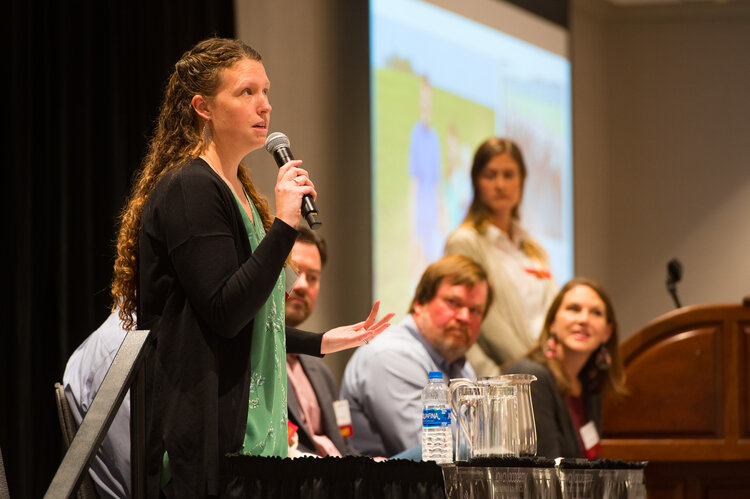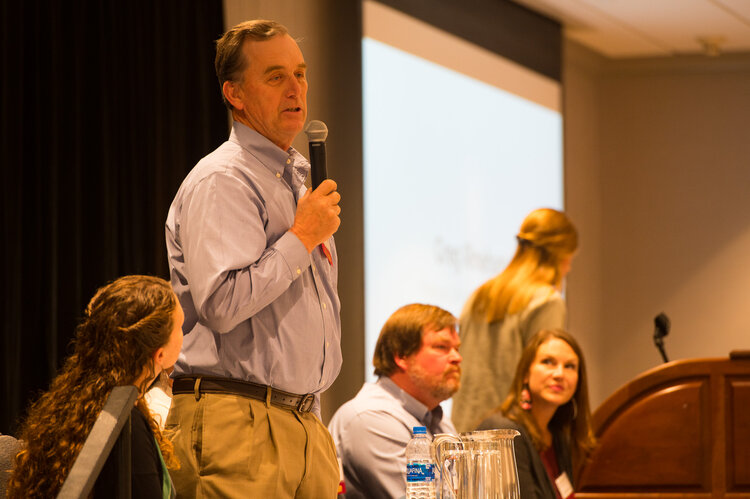3 Essential Farm-to-Fork Insights
December 18, 2019
By Ann Thelen
Six Iowa farmers share three key insights about raising food in a healthy and sustainable way.
Farming is a complicated business. Helping consumers learn where their food comes from and how it's raised can be equally complex.
No longer do consumers simply wheel their carts up and down the grocery aisles, reaching for products simply based on habit and familiarity. Today's consumers want more. Beyond looking at front-of-product packing and nutrition labels, they often want to know more about the farmers raising the food. Nutritionists and dietitians are frequently on the front lines of consumer questions and helping to create the farm-to-fork connection.
From discussing food trends to growing practices, six Iowa farmers shared insights at an Iowa Academy of Nutrition and Dietetics conference. Here are three key things the panel shared.
1. Consumer trends don’t necessarily change the fundamental day-to-day way farmers manage their operations.
 That’s because we have a business model we try to stick to, says Emily Kennedy, who raises cattle with her husband and brother-in-law.
That’s because we have a business model we try to stick to, says Emily Kennedy, who raises cattle with her husband and brother-in-law.
“We follow our model every single day; we’re always trying to make it better and raise healthy cattle in the best manner possible,” she says.
Joan Maxwell, who operates a cattle dairy farm in northeast Iowa with her husband, agrees.
“What changes is how we market. We market what the consumers want because we're already doing what many are asking for, such as producing hormone-free dairy," she says. “Consumer demand tells us what people want to know about how we’re farming.”
While the day-to-day practices stay the same, farmers embrace the opportunities to give consumers what they want to put on their plates.
Katie Hermanson and her husband are fifth-generation farmers, who raise 250,000 turkeys a year.
“What we feed out turkeys has changed," Hermanson says. "Some consumers want to buy vegetarian-fed turkey, so we are adapting. It takes time to make those changes."
“Farms are a business, so we have to grow what is profitable and what people like,” says Greg Rinehart, whose family sells produce and ready-to-eat sandwiches at the Downtown Des Moines Farmers Market. “Over the years, we’ve seen Brussel sprouts gain popularity, so we’re growing more of those.”
Greg and his wife Polly have 10 children, who all have played a role in the family business, Rinehart Farms. Today, three of their daughters are dietitians, furthering the connection between raising food and helping consumers understand what they are eating.
2. When consumer preferences lead to a production shift, farmer investments can be significant.
 In other cases, when the demands call for a wholesale change, the investments can be monumental. Such is the case with cage-free eggs.
In other cases, when the demands call for a wholesale change, the investments can be monumental. Such is the case with cage-free eggs.
Ross Dean is a second-generation egg farmer from Des Moines. Together with his dad and two brothers, they raise and sell egg products over the U.S. and overseas. Ross also serves as chairman of the board for the Food Bank of Iowa.
“We are transitioning to cage-free because that’s what consumers want,” he explains. “Right now, we are 15% cage-free and growing. The biggest challenge we face is the amount of money it takes for the production facilities; there are substantial costs to transition to cage-free.”
Farmers are cognizant of what farmers consumers want, explains Dave Struthers, who has farmed for 36 years. His feeder-to-finish operation markets 6,000 pigs annually. He also raises cattle and grows corn, soybeans and alfalfa crops on 1,200 acres.
“We are constantly weighing everything to keep our animals healthy through proper nutrition and livestock comfort. We want to raise what consumers want, but in doing so, we also need to stay profitable to keep our farm afloat,” he says.
3. There are always trade-offs for different types of farming practices.
For example, milk consumption is down, but dairy consumption is up. The driver is a change in eating habits.
“For breakfast, fewer people are having cereal with milk,” Maxwell says. “Plus, there is an abundance of alternative beverages from iced tea to flavored coffees to non-milk products.”
Long-established companies who once thrived in milk production are filing for bankruptcy.
"Sometimes, what seems like a small dietary change can have severe, unintended consequences," Struthers adds.
On the flip side, dairy consumption is up. The reason, cheese. Various studies show that Americans are eating double the amount of cheese they did 45 years ago.
The farmers unanimously say that when selecting one product over another, it's essential to evaluate the nutritional value of each alternative.
 “We always want to give consumers facts,” Hermanson says. “For example, when a consumer wants turkeys to be fed a vegetarian diet, we explain how the differences between diets will impact the turkeys. Our nutritionists and veterinarians regularly come to the farm and test the feed and the health of our turkeys. We thrive on data to raise the highest-quality turkeys we can.”
“We always want to give consumers facts,” Hermanson says. “For example, when a consumer wants turkeys to be fed a vegetarian diet, we explain how the differences between diets will impact the turkeys. Our nutritionists and veterinarians regularly come to the farm and test the feed and the health of our turkeys. We thrive on data to raise the highest-quality turkeys we can.”
Rinehart agrees that the trade-offs can have an impact in many ways.
“When we raise organic vegetables, we have to use more pesticides and sprays,” he adds. "A GMO seed for sweet corn already has bacteria-resistant genes implanted in it, so it requires fewer pesticides and insecticides. It becomes a matter of personal preference as every method has a trade-off with it.”
To discuss food and farming topics, the Iowa Food & Family Project encourages readers to talk directly with a farmer. If you don’t know a farmer, reach out to us, and we will connect you!